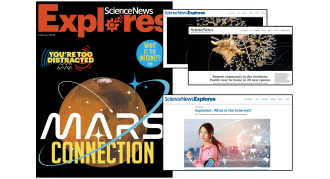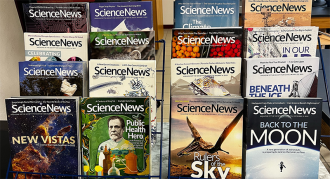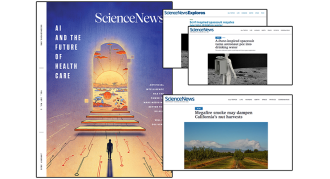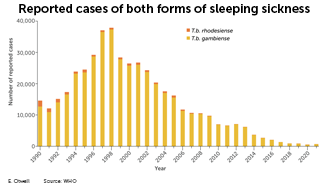Search Results

All About Explainers, Cornell Notes and A New Undersea Mountain
Our first Science News Explores educator guide highlights an article type called Explainers that takes a deep dive into a key scientific concept or process. Use this guide to build a lesson plan based on any Explainer article, learn about the Cornell Note-taking system and download a student template and have students investigate new species found in […]
A whole new world
Ocean explorers just uncovered a treasure trove. A newly discovered undersea mountain may be home to 20 new species. Explore these life forms while answering questions about the value of such discoveries in a time of rapid climate change.
All about Explainers: An article type from Science News Explores
Use this lesson plan to learn about an article type called Explainers that is published by Science News Explores in print and online. You can also access a lesson plan template that can be used with any Explainer article. Explainer articles take a deep dive into a key scientific concept or process.
Literacy Practice: Cornell Note-Taking System
Use this lesson plan and the provided template to have your students practice the Cornell Note-taking System with any article. This literacy strategy organizes notes into two columns that provide structure for note-taking, analysis and review and that will help increase students’ learning, comprehension and retention.

Literacy Practices Templates
Use one of the literacy templates in this guide with any Science News or Science News Explores article. Each template guides students through a different literacy strategy to help increase effective learning, comprehension and retention. These templates were created in collaboration with our Science News Learning Literacy Ambassador Janice Lewis.
Covering Carbon
Climate scientists are continuing to develop new methods to sequester atmospheric carbon to help curb climate change. In this activity, students will learn about how carbon can be sequestered through the burial of organic material and review the carbon cycle. Students will practice using percent by mass concepts and dimensional analysis to calculate how much wood would need to be buried to achieve climate targets by the year 2060. As an optional extension, students may then develop a plan to mitigate greenhouse gas production that utilizes biomass burying techniques.

Photosynthesis and Respiration and a Dune-Inspired Spacesuit
Use articles from the January issue of Science News to review components of respiration and photosynthesis while students investigate what impact megafire smoke may have on California nut trees and have students explore how a Dune-inspired spacesuit may filter urine into drinkable water.
Do the photosynthesis and respiration shuffle
Students will review the components of respiration and photosynthesis reactions to illustrate how the two are complementary. Then students will investigate what impact megafire smoke may have had on photosynthesis for California nut trees. Then students will apply their knowledge by predicting the outcome for photosynthesis and respiration in several scenarios.
Dune-inspired spacesuit
Science fiction sometimes inspires real-world innovation. Future spacesuits may filter urine into drinkable water, allowing astronauts to wear those suits for longer tasks. Learn how researchers propose to make fantasy a reality while answering questions about the filtration techniques and how spacesuits are needed to handle the constraints of space.
Springtail research design and data analysis
Scientists have discovered that Dicyrtomina minuta, a species of globular springtail, can perform the fastest backflip of any animal on Earth. Use this discussion to have students review how the research team studied springtail backflips by analyzing high-speed footage.
Then, in this related activity by DataClassroom, have students analyze graphs of the springtail research data to learn about the linear velocity, angular velocity, linear acceleration and rotational acceleration of springtail flips using this Stacked Graphs and Biophysics with Spring-Loaded Arthropods activity. Create a free account to view the student-facing dataset and activity within the DataClassroom web application. View the teacher answer key here.
Then, in this related activity by DataClassroom, have students analyze graphs of the springtail research data to learn about the linear velocity, angular velocity, linear acceleration and rotational acceleration of springtail flips using this Stacked Graphs and Biophysics with Spring-Loaded Arthropods activity. Create a free account to view the student-facing dataset and activity within the DataClassroom web application. View the teacher answer key here.
Build It: Climate Design Challenge
As global temperatures increase we’ll need to change how we design our buildings. Climate responsive architecture includes buildings that are designed with the regional climate in mind. In this activity, students will design a building that stays at a safe and comfortable temperature throughout the day. In their designs, students will have to consider the Sun’s movement in the sky and their buildings’ materials and shapes. Students will model and test their designs before learning about a new idea scientists have for climate responsive architecture.

Sleeping sickness cases
Cases of sleeping sickness, a disease that can cause brain damage and death, are at an all-time low. An experimental drug called acoziborole could help to eliminate the nightmarish parasitic illness. Use the graph “Sleeping sickness efforts pay off” to have students analyze the reported cases of both forms of sleeping sickness from 1990 to 2021.